Introduction
Design
Front
{{section_header}}{{section.name}}{{/section_header}}

Back
{{section_header}}{{section.name}}{{/section_header}}

Left
{{section_header}}{{section.name}}{{/section_header}}
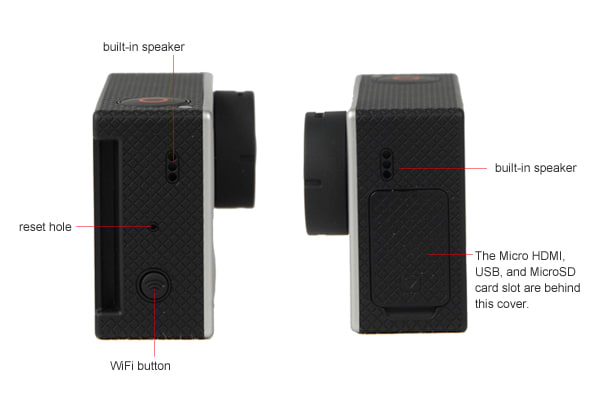
Right
{{section_header}}{{section.name}}{{/section_header}}
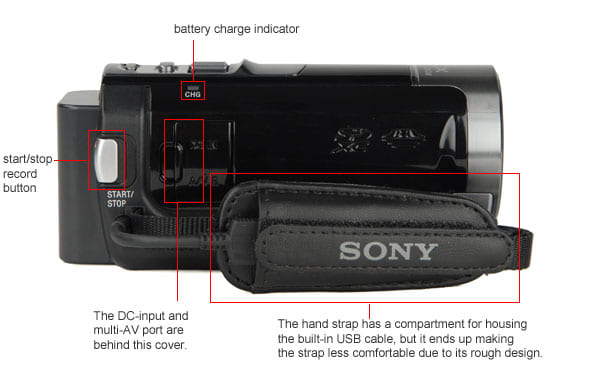
Top
{{section_header}}{{section.name}}{{/section_header}}

Bottom
{{section_header}}{{section.name}}{{/section_header}}

Size & Weight Comparison
{{section_header}}{{section.name}}{{/section_header}}
In the Box
{{section_header}}{{section.name}}{{/section_header}}

Performance
Color
{{section_header}}{{section.name}}{{/section_header}}
JVC camcorders often do extremely well in our color accuracy tests and the GZ-HM340 was no exception. The camcorder managed a color error of 3.24 and a saturation level of 90.22%—both very good scores. Now, a number of JVC's camcorders from last year produced even more accurate colors than this (like the GZ-HM200), but this is a top-notch score nonetheless. More on how we test color.
The color error map above shows the GZ-HM340 had much better accuracy with reds and blues than it did with most yellows and greens. The sample image below shows how the HM340 captured deep, vibrant colors in our bright light test (a point that is accentuated by the 90% saturation level measured in our test). Unfortunately, the JVC GZ-HM340 does not have any manual color controls or picture modes, so you are stuck with the type of color performance you see in the sample image below.
In the comparisons below, notice how the JVC GZ-HM200 produced a slightly more saturated image than the GZ-HM340. Also notice the difference in color tones—particularly with blues and purples—between the two JVC camcorders and the Panasonic and Samsung models. The color patch comparisons that are further down this page will give you a better idea of the color rendering differences offered by these four camcorders.
We like the colors produced by the JVC GZ-HM340 in bright light, and the colors were very accurate in our testing, but you should remember that judging colors has a lot to do with personal preference. Some people may prefer the less saturated tones produced by the Panasonic HDC-TM10 or the Samsung HMX-H106, while others may like the more vibrant colors typically captured by JVC camcorders. Check out the samples and decide for yourself what you think looks best.
{{comparison_bars title="Color Score Comparison", attribute="Color Score", xLabel="Color Score"}}
Low Light Color
{{section_header}}{{section.name}}{{/section_header}}
The GZ-HM340 did a lot better in our low light color and noise tests than it did in our low light sensitivity test. The camcorder managed a color error of 4.22 and a saturation level of 71.47% in this test, both of which are good scores. The saturation level is particularly high here, and it eclipsed the amount we measured on the three comparison camcorders. More on how we test low light color.
We want to stress how strong and vivid the GZ-HM340's colors looked in our low light test; you should check out the comparison images below for a better idea of what we're talking about. The JVC GZ-HM200 and Panasonic HDC-TM10 both look very washed out in comparison to the GZ-HM340, although the Samsung HMX-106 has deep colors that look similar to what the HM340 captured.
Noise
{{section_header}}{{section.name}}{{/section_header}}
The JVC GZ-HM340 also did well in our bright light noise test, with the camcorder averaging 0.5825% noise. This performance is roughly on par with the rest of the camcorders in this set, although the Samsung HMX-H106 was a bit behind the rest of the pack. More on how we test noise.
In addition to showing off the presence of noise and artifacting, the crops above act as a good sharpness comparison. The JVC GZ-HM340 actually captured a sharper image than last year's GZ-HM200 in some ways, but it also showed some significant blur along the bottom of the horizontal trumpet (the HM200 didn't have this problem). It appears JVC also cleaned up some of its discoloration errors that we noticed on last year's HM200, which you should be able to see above (look at the off-color hue in the white portion of the vertical trumpet). From the images above, you can also see that the Samsung HMX-H106 absolutely kills the other camcorders in this set when it comes to sharpness.
{{comparison_bars title="Noise Score Comparison", attribute="Noise Score", xLabel="Noise Score"}}
Low Light Sensitivity
{{section_header}}{{section.name}}{{/section_header}}
The GZ-HM340 did better in our low light sensitivity tests than previous JVC camcorders, but its performance still wasn't very good. The camcorder required 20 lux of light to reach 50 IRE on our waveform monitor, which is below average—even if it is better than some of the other camcorders in this set. Ideally, we like to see a mid-range HD camcorder have a low light sensitivity that is under 15 lux. More on how we test low light sensitivity.
Of the camcorders in this set, only the Samsung HMX-H106 earned a decent score in this test. Still, the improvement of the GZ-HM340 over last year's GZ-HM200 shows that low light sensitivity is an issue JVC is trying to correct. As always, we conducted this test with the GZ-HM340's auto slow shutter turned off (but the camcorder's auto gain control was left on). If you leave the auto slow shutter turned on you will get better low light sensitivity, but your images may appear blurred or choppy due to the 1/30 shutter speed.
{{comparison_bars title="Low Light Sensitivity Comparison", attribute="Low Light Sensitivity Score", xLabel="Low Light Sensitivity Score"}}
Low Light Noise
{{section_header}}{{section.name}}{{/section_header}}
The JVC GZ-HM340 was a top-notch performer in our low light color test. The camcorder averaged just 0.7425% noise in low light, which is only slightly more noise than the camcorder measured in bright light (this is a good thing). The Panasonic HDC-TM10 had similar results in this test, while the JVC GZ-HM200 had some slightly higher noise levels. The Samsung HMX-H106 was the worst camcorder in this set when it came to noise, but it also captured the sharpest image by far. More on how we test low light noise.
While the JVC GZ-HM340 didn't register much noise in our test, its low light image was not very sharp. You can see from the crops above that the camcorder captured a blurred, fuzzy image in low light—although its image was actually crisper than that of the JVC GZ-HM200 and Panasonic HDC-TM10.
{{comparison_bars title="Low Light Noise Score Comparison", attribute="Low Light Noise Score", xLabel="Low Light Noise Score"}}
Low Light Color
{{section_header}}{{section.name}}{{/section_header}}
The GZ-HM340 did a lot better in our low light color and noise tests than it did in our low light sensitivity test. The camcorder managed a color error of 4.22 and a saturation level of 71.47% in this test, both of which are good scores. The saturation level is particularly high here, and it eclipsed the amount we measured on the three comparison camcorders. More on how we test low light color.
We want to stress how strong and vivid the GZ-HM340's colors looked in our low light test; you should check out the comparison images below for a better idea of what we're talking about. The JVC GZ-HM200 and Panasonic HDC-TM10 both look very washed out in comparison to the GZ-HM340, although the Samsung HMX-106 has deep colors that look similar to what the HM340 captured.
Motion
{{section_header}}{{section.name}}{{/section_header}}
The JVC GZ-HM340 didn't render motion spectacularly well in our testing. Its problems were too much artifacting, no alternate frame rates for recording video, and an odd discoloration that was noticeable when we shot our rotating greyscale pinwheel. Its motion image was smooth, however, and it didn't have too much trailing. More on how we test motion.
Video Sharpness
{{section_header}}{{section.name}}{{/section_header}}
Strangely, the JVC GZ-HM340 captured a sharper image in our testing than last year's GZ-HM200. This is the case despite the fact that the HM200 has a larger CMOS sensor than the HM340. We're not entirely sure what caused this improved sharpness, but we assume it must have to do with better processing and the HM340's improved lens.
Even though the GZ-HM340 did well on our sharpness test, we did notice quite a bit of artifacting in the videos we shot with the camcorder. Lines didn't appear as crisp as we would have hoped and fine details often looked fuzzy or blurred. More on how we test video sharpness.
{{comparison_bars title="Video Sharpness Score Comparison", attribute="Video Sharpness Score", xLabel="Video Sharpness Score"}}
Testing Samples
{{section_header}}{{section.name}}{{/section_header}}
Usability
Ease of Use
{{section_header}}{{section.name}}{{/section_header}}
Last year, JVC implemented an interface on its consumer camcorders that was fairly simple to use and easy to understand. The GZ-HM340 uses this same exact interface and the menu structure and design has not changed at all compared to what was featured previously on the JVC GZ-HM200 and GZ-HD300. Like the other models from JVC before it, the GZ-HM340 is at its best when used in its fully automated mode.
This doesn't mean the GZ-HM340 gets a free pass when it comes to ease of use. The Laser Touch system is still very unique and we're sure many people will find it frustrating at first. We also found the Laser Touch strip to be even less responsive than some touchscreen LCD interfaces (particularly when using it to select specific menu options). The menu system on the HM340 is organized as one long menu, which makes it an easy system to figure out, but you can run into problems if you're unsure as to where a certain feature is located.
The menu also has a helpful tool tip box that provides you with information about certain settings. While we do like this info box, we can't say the same thing about JVC's convoluted instruction manual. The manual is printed in a variety of languages, but it omits some very important details about certain features on the camcorder. You can download a more detailed instruction manual from JVC's website, but we even found that document to be lacking in information.
Menus on the JVC GZ-HM340 can be displayed in English, French, Spanish, Portuguese, Japanese, Chinese, Korean, and Hindi.
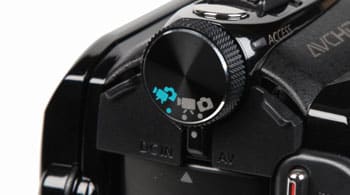
Auto Mode is confusingly called Dual Shot mode
Auto Mode
{{section_header}}{{section.name}}{{/section_header}}
The JVC GZ-HM340 doesn't have any advanced auto controls like AF/AE tracking, but its basic automated features work quite well. The autofocus system is quick and responsive, but we did notice a problem with the focus popping as a subject moved around within the frame. We particularly noticed this issue during our motion test. The auto exposure was more effective, with the camcorder producing smooth transitions between light and dark scenes.
If you are in manual mode but would like the take advantage of the auto exposure, you can choose between whole screen and spot metering. Also in manual mode you have a number of automated features that can help you like backlight compensation and scene modes. We're a bit dismayed that the HM340 only comes with two scene modes—normally a consumer camcorder has between 5-10 scene modes—and we're not really sure why JVC chose to limit something like that.
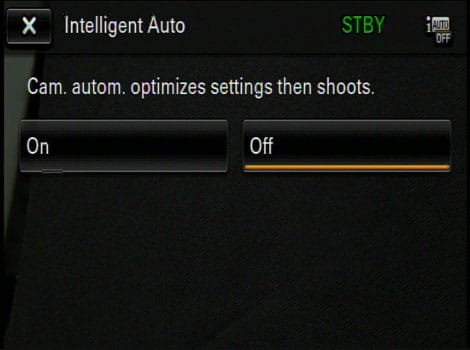
The iAuto mode button is difficult to find, but when you do find it the option for turning on the mode looks like this.
Other Auto Features
Handling
{{section_header}}{{section.name}}{{/section_header}}
The JVC GZ-HM340 has a very similar design to last year's GZ-HM200 from JVC. The camcorder's compact design feels fairly comfortable in your hand, but the flimsy hand strap doesn't provide much support—which has been the case on most mid-range and entry-level models from JVC over the past couple of years.This year, however, JVC added a little release button to the HM340 that turns the hand strap into a wrist strap (see image below). This release button is a good move by JVC, but it still doesn't help with the fact that the strap is awful when it is used as a traditional hand support.


If you've ever used a JVC camcorder from the past two years, you've had experience with the Laser Touch system. The Laser Touch is similar to using a touchscreen interface, but it has its own set of quirks and performance issues. We found the Laser Touch to be a very frustrating navigation tool when trying to select a specific menu option, but the system works well for quickly scrolling through options (you can slide your finder along the strip to scroll).

The GZ-HM340 feels rather cheap, but it isn't much different than most entry-level consumer camcorders. Its body is prone to scratching, many of its ports are unprotected (inside the LCD cavity), it doesn't have a built-in lens cover, and its LCD has a lackluster 123,000-pixel resolution. There isn't anything really special about the camcorder's design: it's small and feels cheap.

These dedicated buttons give you quick access to aperture and shutter speed controls.
Portability
{{section_header}}{{section.name}}{{/section_header}}
For a traditional camcorder with a horizontal design the JVC GZ-HM340 is a very compact product. It weighs only 255g fully loaded, which is lighter than all of the models we used as comparisons. We're not saying the HM340 is a small as an ultracompact model like a Flip camcorder, but it shouldn't be much of a hassle to bring it along on a day trip or vacation. You could probably even stuff the GZ-HM340 into your pocket as long as it was a fairly loose pocket, but the camcorder would be better suited in a small bag or purse.
One thing we don't like is the fact that the GZ-HM340 does not have a built-in lens cover, which can expose its precious lens to dirt or scratches if you toss it into a bag. The camcorder does come with a removable lens cover, however, and the cover fits better than most. Still, even well-fitting lens covers are prone to popping off if you're not careful.
Battery Life
{{section_header}}{{section.name}}{{/section_header}}
The JVC GZ-HM340 did a fairly good job in our battery life test. The camcorder lasted for 2 hours, 7 minutes, and 47 seconds in our testing (127 minutes), which is a good 15 minutes longer than the JVC GZ-HM200 lasted. Another benefit of the GZ-HM340 is the fact that it has an open-ended battery compartment. So, if you want longer battery life you can just buy a larger battery pack that's compatible with the camcorder. More on how we test battery life.

{{comparison_bars title="Battery Life Comparison", attribute="Battery Life Score", xLabel="minutes"}}
LCD
{{section_header}}{{section.name}}{{/section_header}}
The GZ-HM340's LCD isn't anything special. It has the same 2.7-inch screen and 123,000-pixel resolution as last year's GZ-HM200. These specs aren't fantastic when you consider most other manufacturers offer LCDs with much higher resolution, although the 2.7-inch size is standard for a mid-range camcorder. The GZ-HM340, like most mid-range models, does not include a viewfinder.
You can adjust the LCD by setting the backlight to auto, standard, or brighter. You can also select one of eleven specific LCD brightness levels. Adjusting these settings can help you conserve battery life, but they can also make it difficult to know whether your videos have proper exposure levels.
Stabilization
{{section_header}}{{section.name}}{{/section_header}}
JVC outfitted the GZ-HM340 with a new stabilization system this year, but unfortunately it didn't do very well in our test. The camcorder still uses a digital stabilization system, but the GZ-HM340 has two settings instead of just one (like the JVC GZ-HM200 had). Interestingly, however, we noticed no difference between the two settings in our testing. In our low shake test, the GZ-HM340 reduced 23% of the shake with its stabilization turned on. With the high shake test the camcorder reduced slightly less shake: 16%. More on how we test stabilization.
JVC claims the image stabilization 2 setting is meant for wide angle shots or shots with limited zoom. This helps explain why we saw very little difference between the two stabilization modes in our testing (all of our stabilization testing is done at full optical zoom). The video below shows the GZ-HM340's stabilization system in action. You can see that the stabilization does do an adequate job at times, but it simply wasn't as good as on last year's JVC GZ-HM200 or the Panasonic HDC-TM10.
Manual Focus
{{section_header}}{{section.name}}{{/section_header}}
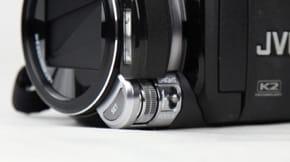
The adjustment dial makes accurate focus adjustments easy.
Manual Exposure
{{section_header}}{{section.name}}{{/section_header}}
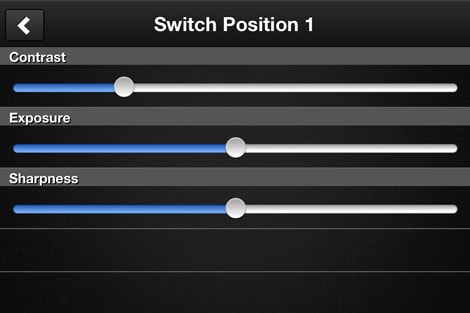
The manual exposure controls are only found on the Contour app, not on the camcorder itself.
Miscellaneous Controls
{{section_header}}{{section.name}}{{/section_header}}
x.v.Color
Allows for recording in the expanded xvYCC color gamut.
TeleMacro
Adjusts the focal range for shooting subjects very close to the lens.
Audio Controls
{{section_header}}{{section.name}}{{/section_header}}
JVC didn't load the GZ-HM340 with any state of the art audio features. In fact, the camcorder doesn't really have any audio features or controls other than its stereo built-in microphone and a wind cut option. We do like placement of the built-in mic, however, as its front-mounted position is out of the way from wandering fingers or noisy controls. If you want extensive audio controls (or an external mic jack) you're basically out of luck with the four camcorders listed in the table below. The Panasonic HDC-TM10 has the most features of the camcorders listed below, while all consumer camcorders from Canon include external microphone jacks.
Editing
{{section_header}}{{section.name}}{{/section_header}}
The GZ-HM340 ships with a new version of Everio Media Browser HD (version 2.0.6). When you connect your camcorder to a computer with the software installed, the software should open automatically and allow you to import your clips. This is same software that is activated if you recorded your footage using the 'one-touch' upload feature. This button, located in the LCD cavity, is somewhat confusing: you can't record your video, then push the button to upload to YouTube. Instead, you have to press the button ahead of time, record the footage, then plug the HM340 into your computer. The videos you recorded in 'one-touch' mode will be automatically selected for upload to YouTube. For an overview of the software that ships with this and other camcorders, see our article: Video Editing Software For Your Camcorder{{product.brand.name}}-Included-Software.htm.
In addition to this provided software, the GZ-HM340 has some internal editing features. You can trim and split clips, add faders or wipes, and create playlists right on the camcorder itself.
Features
Compression
{{section_header}}{{section.name}}{{/section_header}}
The JVC GZ-HM340 uses the AVC/H.264 codec to compress video and the camcorder is AVCHD compliant. That means it has the same compression system used by most HD camcorders from Sony, Canon, and Panasonic.
The GZ-HM340 has four quality options for recording HD video, but the camcorder has no standard definition recording setting. The top quality option—UXP—records at a maximum bitrate of 24Mbps, which is the highest bitrate possible with AVCHD recording. Read more about the advantages and disadvantages of various high definition compression types.
Media
{{section_header}}{{section.name}}{{/section_header}}
The GZ-HM340 has two options for recording media: 16GB of internal flash memory and an SD/SDHC memory card slot. The 16GB of internal flash memory isn't a lot—there are many models out there with upwards of 64GB of internal flash memory—but it is still a good feature to have.
With the memory card slot as a backup, you can also take advantage of JVC's 'seamless recording,' which will automatically continue recording on the memory card once you've filled up the internal memory. The table below lists the approximate record times for the GZ-HM340: Read more about the advantages and disadvantages of various media types.

Slow Motion Modes
Still Features
{{section_header}}{{section.name}}{{/section_header}}
Let's be clear, the GZ-HM340 is not a good camcorder for taking still photos. Its sensor is very small, which means it doesn't have a very high pixel count for still images (its effective pixel count in still image mode is between 0.56 and 1.09 megapixels depending on what aspect ratio you shoot with). You are guaranteed to get better still images from even a cheap digital camera. Still, if you're in a pinch you can capture photos with the GZ-HM340 and the camcorder even has a dedicated still image mode.
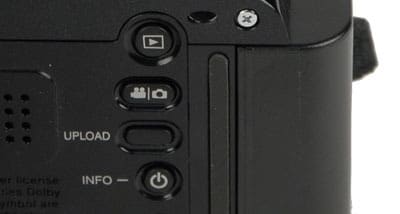
You can take photos in three sizes with the HM340: 1920 x 1080, 1440 x 1080, or 640 x 480. The thing is, only the 640 x 480 setting is a native resolution—the other two are interpolated because they use more pixels than the camcorder has available. The camcorder has no built-in flash, but you can capture still images during recording. See the table below for the full list of still image features.
The GZ-HM340 did well in our still color testing: the camcorder measured a color error of 4.00 and produced a saturation level of 108.5%. These numbers are similar to what the camcorder earned in our bright light video testing, which means there shouldn't be much of a difference in color between photos and videos captured by the GZ-HM340.
All four of the camcorders shown below only capture still photos with a 16:9 aspect ratio. The HM340 has much deeper colors than the Samsung HMX-H106, but it also captured a slightly darker image than the rest of the models.
The 0.75% noise we measured on the GZ-HM340's still images isn't the best score, but it's not awful. We would have liked to see a noise level that was more akin to what the camcorder earned in our bright light video testing (around 0.58% noise). Still, the HM340's still noise performance was roughly on par with the JVC GZ-HM200 and Samsung HMX-H106.
The GZ-HM340 doesn't capture high-resolution still images, so it should come as no surprise that the camcorder flunked our still sharpness test. At best, the HM340 measured a horizontal sharpness of 718 lw/ph with 23.6% oversharpening and a vertical sharpness of only 458 lw/ph with 24.1% undersharpening. These numbers are simply no good—even for a mid-range HD camcorder—and they are significantly lower than what we measured on last year's JVC GZ-HM200. Still, we can't really fault the GZ-HM340 for doing poorly on this test. The camcorder really doesn't have the photo specs to succeed as a still image camera.
Lens & Imaging System
{{section_header}}{{section.name}}{{/section_header}}

The GZ-HM340 has a very small CMOS sensor for an HD camcorder, which is why we consider it an entry-level model. The sensor is quite a bit smaller than JVC's mid-range camcorders from last year (like the GZ-HM200 or the GZ-HD300), while the lens has the same 20x optical zoom. One difference with the lens on the GZ-HM340, however, is the fact that it does not have a built-in cover (a removable lens cover does ship with the camcorder).
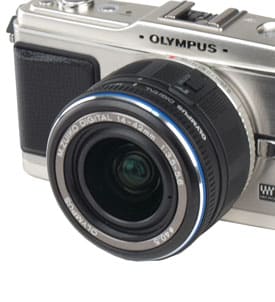
LCD
{{section_header}}{{section.name}}{{/section_header}}
The GZ-HM340's LCD isn't anything special. It has the same 2.7-inch screen and 123,000-pixel resolution as last year's GZ-HM200. These specs aren't fantastic when you consider most other manufacturers offer LCDs with much higher resolution, although the 2.7-inch size is standard for a mid-range camcorder. The GZ-HM340, like most mid-range models, does not include a viewfinder.
You can adjust the LCD by setting the backlight to auto, standard, or brighter. You can also select one of eleven specific LCD brightness levels. Adjusting these settings can help you conserve battery life, but they can also make it difficult to know whether your videos have proper exposure levels.
Connectivity
{{section_header}}{{section.name}}{{/section_header}}
The connectivity features on the GZ-HM340 are limited, but the camcorder has all of the important ones. Inside the LCD cavity you'll find an HDMI terminal, Component video output, and a standard AV-out port. None of these ports have any covers, but they do get some protection when the LCD panel is closed.
On the back of the camcorder you'll find a little plastic flap above the battery pack. Flip this up and you find a USB port and a DC-input. We like the fact that these ports are protected, but the plastic flap that covers them doesn't feel very strong and we felt like it was only a matter of time before its flimsy tether fell apart. These two ports are also rather close together, which made things a little cramped when we had both a USB cable and a power cable plugged in at the same time.
The only other connectivity feature on the GZ-HM340 is its memory card slot that accepts SD or SDHC memory cards. The card slot is on the bottom of the camcorder behind a long, flip down door. The door provides adequate protection, but it really doesn't have to be as long as it is (it looks like it was built to accommodate for two card slots).
All of the mid-range camcorders shown below have very similar connectivity features. None of them include external mic jacks, headphone outputs, or accessory shoes. If you desire those sorts of connectivity options, you should check out Canon's mid-range models or spring for a high-end consumer camcorder.
Media
{{section_header}}{{section.name}}{{/section_header}}
The GZ-HM340 has two options for recording media: 16GB of internal flash memory and an SD/SDHC memory card slot. The 16GB of internal flash memory isn't a lot—there are many models out there with upwards of 64GB of internal flash memory—but it is still a good feature to have.
With the memory card slot as a backup, you can also take advantage of JVC's 'seamless recording,' which will automatically continue recording on the memory card once you've filled up the internal memory. The table below lists the approximate record times for the GZ-HM340: Read more about the advantages and disadvantages of various media types.

Still Features
{{section_header}}{{section.name}}{{/section_header}}
Let's be clear, the GZ-HM340 is not a good camcorder for taking still photos. Its sensor is very small, which means it doesn't have a very high pixel count for still images (its effective pixel count in still image mode is between 0.56 and 1.09 megapixels depending on what aspect ratio you shoot with). You are guaranteed to get better still images from even a cheap digital camera. Still, if you're in a pinch you can capture photos with the GZ-HM340 and the camcorder even has a dedicated still image mode.

You can take photos in three sizes with the HM340: 1920 x 1080, 1440 x 1080, or 640 x 480. The thing is, only the 640 x 480 setting is a native resolution—the other two are interpolated because they use more pixels than the camcorder has available. The camcorder has no built-in flash, but you can capture still images during recording. See the table below for the full list of still image features.
The GZ-HM340 did well in our still color testing: the camcorder measured a color error of 4.00 and produced a saturation level of 108.5%. These numbers are similar to what the camcorder earned in our bright light video testing, which means there shouldn't be much of a difference in color between photos and videos captured by the GZ-HM340.
All four of the camcorders shown below only capture still photos with a 16:9 aspect ratio. The HM340 has much deeper colors than the Samsung HMX-H106, but it also captured a slightly darker image than the rest of the models.
The 0.75% noise we measured on the GZ-HM340's still images isn't the best score, but it's not awful. We would have liked to see a noise level that was more akin to what the camcorder earned in our bright light video testing (around 0.58% noise). Still, the HM340's still noise performance was roughly on par with the JVC GZ-HM200 and Samsung HMX-H106.
The GZ-HM340 doesn't capture high-resolution still images, so it should come as no surprise that the camcorder flunked our still sharpness test. At best, the HM340 measured a horizontal sharpness of 718 lw/ph with 23.6% oversharpening and a vertical sharpness of only 458 lw/ph with 24.1% undersharpening. These numbers are simply no good—even for a mid-range HD camcorder—and they are significantly lower than what we measured on last year's JVC GZ-HM200. Still, we can't really fault the GZ-HM340 for doing poorly on this test. The camcorder really doesn't have the photo specs to succeed as a still image camera.
Other Features
{{section_header}}{{section.name}}{{/section_header}}
Auto Record
New to JVC's 2010 lineup, this function is known by some as the 'Nanny Cam.' You can set up the camera in a specific location and it will automatically start recording when a new subject enters the frame. Use it for sneaky video surveillance. Or self-recording.
Seamless Recording
Known on many camcorders as 'relay record,' seamless recording allows you to automatically switch over and record to a second media type when your current media is full. On the HM340, this means that if you fill up the internal memory, the camcorder will automatically continue recording on the memory card.
Time Lapse Recording
You can take short video clips at set intervals over an extended period of time. It's not quite suited to filming the changing colors of autumn foliage, but you can capture changes over a shorter period. Available intervals include: 1, 2, 5, 10, 20, 40, and 80 seconds.
One Touch Upload
The GZ-HM340 carries over only one of JVC's standard 'one-touch' features from 2009: one-touch upload. The button is located in the LCD cavity and is designed to make upload to YouTube easy. Unfortunately, the process it's as easy as it should be. You have to install JVC's provided editing software before you can use this feature, and the 'one-touch' button must be activated before you start recording. Read more about this feature in our article: 'Video Editing Software For Your Camcorder'.
Quick Restart
Like most consumer camcorders, the HM340 can be powered up more quickly by simply opening the LCD panel. This allows you to turn on the camcorder and start recording in just a couple seconds.
Info
The power button inside the LCD doubles as an Info button. Press this button to see information on remaining recording time (based on the available capacity of the internal memory). There's also a tab for viewing remaining battery life.
Digital Effects
Jazz up your footage with a cheesy digital effect. Choices include sepia, black and white, classic film, and strobe.
Panasonic HDC-TM10 Comparison
Even though it came out last year, the JVC GZ-HM200 is really not much different than the GZ-HM340. Despite the fact that the camcorders have different CMOS sensors, the two models performed similarly in our testing. The GZ-HM340 came out on top in low light, while the GZ-HM200 had better still image performance and stronger color accuracy in bright light. It's somewhat tough to pick a winner between these two when it comes to performance.
The GZ-HM200 does have a few more manual controls than the GZ-HM340, although it is missing features like Time Lapse Record and Auto Record that are both available on the HM340. One of the few concrete advantages of the GZ-HM340 is the fact that it contains 16GB of internal flash memory compared to none on the HM200. The GZ-HM200 does have two SD/SDHC card slots, however, and it has the same seamless recording function that is featured on the GZ-HM340.
The design of these two models is nearly identical, with the HM340 being a tad smaller and roughly 50g lighter than the HM200. If you're shopping based on price, you probably won't notice much of a difference either—the GZ-HM200 lists around $60 more than the GZ-HM340, but you can probably find an HM200 on the cheap if you shop around.
Overall, we'd probably have to give the GZ-HM200 the advantage here. It was, after all, our pick for best mid-range camcorder last year. We simply didn't feel JVC made any significant improvements with the GZ-HM340 for it to warrant higher praise than the GZ-HM200. Is the GZ-HM340 still a good entry-level or mid-range model? Sure, but we like the GZ-HM200 a little more.
Samsung HMX-H106 Comparison
The GZ-HM340 and Panasonic HDC-TM10 are similar camcorders when it comes to performance, but they are very different when it comes to interface and design. Even both camcorders are the same size, they each offer a very different recording experience. The HDC-TM10 uses a touchscreen interface, while the GZ-HM340 has JVC's Laser Touch system. Overall, we like the touchscreen a bit more, but both systems have their frustrating quirks.
One significant advantage of the Panasonic is the fact that it has far more manual control options than the JVC. Both camcorders have good auto modes, although the HDC-TM10 has some more valuable automatic controls (like AF/AE tracking). What are the significant differences when it comes to performance? Well, the GZ-HM340 is better in low light, while the Panasonic HDC-TM10 did better in our stabilization and still image tests.
There isn't really a clear cut winner between these two camcorders unless you like having access to lots of manual controls (then you should go with the Panasonic). If you're going to be doing the majority of your shooting in auto mode, then it is difficult to say what the better option is. Our recommendation would be to go for whichever camcorder you can find at a lower price (keep in mind, though, that the GZ-HM340 has double the internal flash memory of the Panasonic HDC-TM10).
COMP 3
The Samsung HMX-H106 is a lot more expensive than the JVC GZ-HM340, but for the extra cash you get far better video performance. In our testing, the HMX-H106 often rivaled the best consumer camcorders of 2009, while the GZ-HM340 consistently performed like a solid mid-range model. All you need to do is look how sharp the image from the HMX-H106 is as compared to the JVC GZ-HM340 to understand what we are talking about.
Besides performance, the Samsung HMX-H106 also has a better design than the GZ-HM340. Some people may not like the unique hand strap system on the Samsung, but we found it made the camcorder more comfortable to use and a more versatile product overall.The Samsung does use a touchscreen interface, however, so keep that in mind when you compare it with the JVC. The HMX-H106 also has 64GB of internal memory, which is a boatload more than what the GZ-HM340 comes with.
The JVC is a much smaller camcorder than the HMX-H106, which is really its only advantage over the Samsung—other than price. If video performance is a primary concern of yours we have to recommend the Samsung HMX-H106 (or its sister models the HMX-H105 and HMX-H104) over the JVC GZ-HM340.
Conclusion
For an HD camcorder that lists for under $500, the JVC GZ-HM340 is a rather impressive piece of technology. The camcorder has a tiny CMOS sensor, but it performed on par with last year's GZ-HM200 from JVC—which won our award for best mid-range camcorder of the year (in 2009). In fact, the GZ-HM340 did better than the GZ-HM200 in all of our low light tests.
Even though its performance surprised us, the GZ-HM340 is still a fairly low-end camcorder. It features little in the way of manual controls and it has a number of weaknesses when it comes to handling. Its performance is also nowhere near as good as more expensive HD camcorders like the Samsung HMX-H106, Canon HF20, or Panasonic HDC-HS60—not to mention all of the flagship models from the major manufacturers.
If you're looking for a cheap, simple HD camcorder the JVC GZ-HM340 is a decent option. However, there are plenty of other mid-range camcorders hitting the shelves in 2010 that have better performance and more elaborate features than the GZ-HM340. If you're in the market for a mid-range model we think the best idea would be to shop around and look for a good deal on the Panasonic HDC-HS60 (or its sister models the HDC-SD60 and HDC-TM55) or wait for our reviews of the new mid-range models from Canon and Sony.
Photo Gallery
{{photo_gallery "Front Photo", "Left Photo", "Left Open Photo", "Back Photo", "Right Photo", "Top Photo", "Bottom Photo", "Lens Photo", "Lens Photo 2", "3D Lens Photo", "Media Photo", "Easy Mode Photo", "Manual Controls Photo", "Zoom Photo", "Zoom Photo 2", "Ease of Use Photo", "Battery Photo", "LCD Photo 1", "LCD Photo 2", "EVF Photo 1", "EVF Photo 2", "Mic Photo", "Mic Photo 2", "Ports Photo 1", "Ports Photo 2", "Ports Photo 3", "Ports Photo 4", "Ports Photo 5", "Ports Photo 6", "Handling Photo 1", "Handling Photo 2", "Handling Photo 3", "Handling Photo 4", "Box Photo"}}
Meet the tester
Jeremy is the video expert of our imaging team and Reviewed.com's head of video production. Originally from Pennsylvania and upstate NY, he graduated from Bard college with a degree in film and electronic media. He has been living and working in New England since 2005.
Checking our work.
Our team is here for one purpose: to help you buy the best stuff and love what you own. Our writers, editors, and lab technicians obsess over the products we cover to make sure you're confident and satisfied. Have a different opinion about something we recommend? Email us and we'll compare notes.
Shoot us an email
